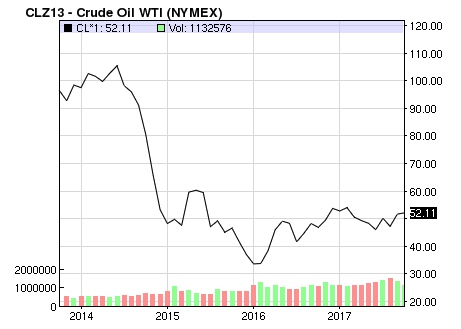Economies can rise or fall depending on the fluctuations of oil prices. Industries that are reliant on fuel costs can experience either a good or bad quarter due to these fluctuations. The volatility of oil prices always gets people thinking – “What is the price of oil going to be 6 months from now? Next year? In 2 years?” These are valid questions to consider while managing your budget at either a personal level, such as purchasing or leasing a car, or even while making important business decisions. Unfortunately, there are no analysts, experts, or commentators that will be able to decisively and accurately forecast the price of oil. However, it is certainly possible to make a well-educated guess about the short-term and long-term direction of oil prices by looking at future contracts.

According to The Options Guide, “Crude Oil futures are standardized, exchange-traded contracts in which the contract buyer agrees to take delivery, from the seller, a specific quantity of crude oil (eg. 1000 barrels) at a predetermined price on a future delivery date” (The Options Guide). In other words, a futures contract guarantees the buyer his or her commodity at the contract price, regardless of the market price at that specific date. These futures are traded in the New York Mercantile Exchange (or NYMEX) and the Intercontinental Exchange (ICE) where West Texas Intermediate (WTI) and North Sea Brent crude oil are traded respectively. Traders can buy or sell oil for delivery many months or years ahead. Historically, the majority of activity in commodity futures markets had been focused on oil for delivery in the next few months. However, in recent years, the activity has increased for more future deliveries as more investors had begun pouring money into it.
These future contracts evolved many years ago, with farmers being known as the pioneers of it all. Farmers, or sellers, and dealers, or buyers, would agree to a future exchange of grain for cash. For example, a farmer would agree to deliver 7,000 bushels of wheat to the dealer at the end of July for a set cost. This exchange would be beneficial for both the farmer and the dealer. The farmer would know how much wheat would be in demand so he would not come too short or have a surplus, as well as knowing how much he will be getting paid in advance. On the other hand, dealers were able to budget accordingly by knowing their costs in advance.

These contracts became very common and were even used as collateral for bank loans. But soon enough, the consequence we face with any contract arose; how do you back out if you are locked in? As a result, farmers and dealers began selling contracts before the delivery dates. For example, if the dealer still had a surplus of inventory as the new delivery date approached and he did not want to purchase the new wheat, he would sell the contract to someone who did. Or, if the farmer did not have the capability to produce and deliver the wheat, he would sell the contract and obligation to another farmer. This caused the prices of wheat to go up and down, depending on what was happening in the wheat market. Weather conditions would play a role in the pricing as well. If there was bad weather, the sellers of the wheat in the contract would hold more valuable contracts because the supply would be lower, and if weather conditions were ideal then the sellers’ contracts would become less valuable. Not everyone had a reason to buy and sell wheat, but saw this as a way to make money. It did not take long before people began to make side bets and trade these contracts, hoping to buy low and sell high, or sell high and buy low.
This concept, first developed by farmers, is mirrored in the oil industry today. Companies that have an interest in oil for their daily operations are known to participate in future exchanges, such as refineries or airline companies. Their intent is to reduce the risk of volatility in the price of oil, and are known as “hedgers.” Producers of crude oil can engage in a “short hedge,” which locks in a selling price for the oil they produce. This allows them to manage their operations to produce just the right amount to not experience a shortage or surplus. Also, similar to the farmers, it allows producers to know how much they will be getting paid in the future, which can impact key business and budget decisions. Businesses that require crude oil can participate in a “long hedge,” which will guarantee a purchase price for the commodity for a specific quantity at a specific date. Similar to the dealers involved with the wheat contracts, businesses that purchase oil will know exactly how much their oil costs will be in the future and can operate and budget accordingly.
So, if the wheat market attracted people to make side bets and trade contracts, shouldn’t the crude oil market do the same? The answer is yes. Crude oil futures are also traded by “speculators,” who make an assumption on the price risks that hedgers aim to avoid in efforts to gain a profit. In other words, crude oil futures allow you to make money of the fluctuations of the price per barrel, but are very different than buying oil or stocks of a gas company. The stock market involves trading investments in different publicly traded companies, and similarly, people also trade in commodities at financial markets. Speculators will purchase crude oil futures if they believe that the crude oil price will go up, and will sell the futures when they think the prices will fall.
 Obviously, these investors have no desire to acquire the thousands of barrels of crude oil they are trading. Fortunately, participators in trading do not have to actually deal with physical deliveries if traded and finalized before the expiration date of the contracts. It is necessary to have a margin account with a broker and maintain a certain amount of equity in the account in case you experience a loss. According to Dan Caplinger, a writer and Director of Investment Planning for the Motley Fool, “For NYMEX crude oil futures, the current margin maintenance requirements range from $2,900 to $3,400 depending on the date of the contract” (The Motley Fool). If the losses result in a decrease of available capital below that level, more money must be deposited in order to keep the futures position.
Obviously, these investors have no desire to acquire the thousands of barrels of crude oil they are trading. Fortunately, participators in trading do not have to actually deal with physical deliveries if traded and finalized before the expiration date of the contracts. It is necessary to have a margin account with a broker and maintain a certain amount of equity in the account in case you experience a loss. According to Dan Caplinger, a writer and Director of Investment Planning for the Motley Fool, “For NYMEX crude oil futures, the current margin maintenance requirements range from $2,900 to $3,400 depending on the date of the contract” (The Motley Fool). If the losses result in a decrease of available capital below that level, more money must be deposited in order to keep the futures position.
Crude oil prices are important for investors in energy companies, even if the investor does not personally trade in futures. Energy companies that people invest in are likely to use futures for their own account. Knowing the mechanisms of how crude oil futures work gives you a better understanding of why the share prices of these companies are either going up or down as a reaction to the change in oil prices. For example, if a producer has sold a lot of futures that cover almost all if its future production, it should not experience that much of a reaction when oil prices change since it is already locked in. People that do not participate in futures markets will notice the volatility of oil prices as they increase or decrease and do not have the balance.
Crude oil futures play an essential role in how the energy industry operates. Future contracts will allow companies to manage their operations and potentially boost their profits by planning accordingly. However, futures markets can be very risky for investors to participate in. Understanding how futures work are not only important to companies and investors, but even average individual consumers that rely on different energy companies as their primary sources of energy. The price we pay at the pump is a reaction to how well the energy industry is doing.
Although these is no definite way to know which direction the price of oil will sway, it is possible to conduct an accurate forecast for both the short and long run. There is no hidden “secret” for how to predict the future price of oil. The balance of supply and demand causes the prices to fluctuate, but it is not the supply and demand for the actual oil. Instead, it is the supply and demand of the investment. The increase or decrease in demand in relation to the supply of investment will ultimately determine the price of oil. This is all apparent in the oil futures market where futures are traded. Investors will make a prediction, derived from different economic predictions, on whether to purchase futures that will reflect them, causing prices to go either up or down. Studying how much these future contracts are that are being traded for in the short run and in the long run will allow you to make a well-educated guess on what direction oil prices will be going.
https://www.fool.com/investing/2016/07/12/what-are-crude-oil-futures-and-how-do-they-work.aspx
http://www.theoptionsguide.com/crude-oil-futures.aspx
https://science.howstuffworks.com/environmental/energy/crude-oil-market3.htm
http://eh.net/encyclopedia/a-history-of-futures-trading-in-the-united-states/
http://www.nasdaq.com/markets/crude-oil.aspx
Leave a Reply
You must be logged in to post a comment.